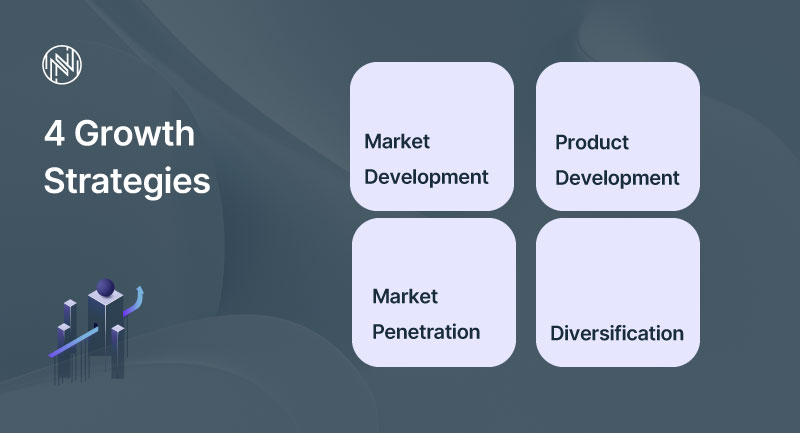
The four growth strategies are market penetration, market development, product development, and diversification. The biggest question every business leader must ask is: How do we grow? Whether you’re scaling a startup, pitching to venture capitalists, or leading an established company, understanding business growth strategies is the key to long-term success.
The solution lies in a framework that has guided organizations for decades — the Ansoff Matrix. It outlines four distinct avenues for expansion, each with its own strengths and limitations. This business development model serves as a roadmap to help you choose the strategy that best aligns with your organization’s goals.
Understanding the Ansoff Matrix
It is crucial to understand the framework’s foundation before implementing specific strategies. The Ansoff Matrix is a strategic tool developed by Igor Ansoff, a business strategist, to assess growth opportunities along two dimensions: product and market. This forms four quadrants, which represent various strategic directions. The four strategies are low-risk and high-risk strategies. The decision would be based on your current market position, the resources available to you, and your willingness to take calculated risks. It is time to discuss each of the strategies.
Market Penetration: Maximizing Current Opportunities
Market penetration focuses on increasing a company’s market share of available products. This is the safest of the four business growth strategies since you are in a territory that you know well. The idea is straightforward: promote more of what you already have to people who already know about you. This includes stealing away the competition’s customers, motivating existing customers to make additional purchases, and attracting previously unexploited markets within your existing market.
Effective tactics include:
- Price wars that make your services more competitive.
- Sensitization through aggressive marketing campaigns aimed at raising brand awareness.
- Improved customer service programs that establish loyalty.
- Alliance with other companies that increase your distribution channels.
The examples of growth strategy are numerous. Market penetration is one of the strategies employed by McDonald’s when conducting promotional campaigns to increase the frequency of visits. Netflix uses this approach by developing high-quality content that reduces subscriber churn and attracts new customers in existing markets.
Market Development: Expanding Your Reach
A market development strategy introduces your established products in new markets. This may imply geographical expansion, appealing to other customer groups, or seeking additional applications for current offerings. This strategy is moderate risk, as it familiarizes people with familiar products. Understanding new markets, cultural differences, and competition locally is key to success.
Key implementation methods include:
- Expansion into new countries or geographies.
- Age or income bracket demographic targeting.
- The introduction of new distribution channels, e.g., e-commerce platforms or retail partners.
- Rebranding efforts that appeal to various groups of customers.
Starbucks is an example of good market development. The company was expanding into urban centers, moving from suburban to international markets, and preserving its store products. This strategy is common among technology firms entering emerging markets with existing software solutions. Success in one market may require adjustments in another. The growth strategy requires comprehensive market research, localization, and patience in the entry phase.
Product Development: Innovation for Existing Customers
A product development strategy emphasizes developing new products for your existing customers. This generates support for your existing ties and adds to your product line. This method leverages customer trust and market knowledge. You have known the needs, pain points, and preferences of your audience. The key is to innovate with product development that adds real value without cannibalizing existing sales.
Strategic considerations include:
- Investments in new features or products through research and development.
- Customer feedback is integrated into product roadmaps.
- Technological advancements drive innovation in the latest market trends.
Apple has excellence in product development. Every iPhone product is a new, feature-rich device that retains its core concept while remaining innovative. This strategy is effectively employed by SaaS companies that regularly roll out new modules and features, aiming to add value to existing subscribers. The risk is medium and high. The cost of development may be high, and it may not be accepted in the market. Nonetheless, effective product development makes customers more loyal and introduces several new sources of revenue among existing audiences.
Diversification: Bold Expansion into New Territory
The most significant risk and greatest reward in all corporate growth strategies is diversification. This strategy involves creating new products in entirely new markets simultaneously. Two types exist. Corresponding diversification extends to those industries related to your business. An example of such an approach is a manufacturer of fitness equipment that introduces nutritional supplements. Unrelated diversification ventures into other independent industries. This bold strategy is evident in the fact that the Virgin Group began with music and subsequently expanded into the airline and telecommunications industries.
Critical success factors include:
- Heavy capital investment will be made on two fronts.
- Extensive market analysis through exotic markets.
- Strategic acquisitions/alliances that speed up market entry.
- Strong organizational capacity to handle increased complexity.
The benefits of diversification are great considering the risks. It cushions against industry-specific weakness, generates multiple sources of revenue, and provides new points of growth as the core markets mature. However, allocating resources in a new territory requires extraordinary management skills. Most diversification initiatives in the market fail due to inadequate planning or insufficient funding.
Selecting Your Growth Path
It is necessary to be honest in determining the appropriate business growth strategy. Consider your current market position, competition, and available resources. Decision-makers are required to evaluate every alternative based on financial estimates, market studies, and aligning core competencies. Most successful organizations employ a variety of strategies, either one at a time or all, simultaneously, as they develop.
Moving Forward
Knowledge of these four growth strategies will give a map for expansion. Whether market penetration, market development, product development, or diversification, bold vision and strategic planning of growth require intentional implementation.
Nexus Expert Research is the connection between you and certified experts who offer real-time advice on your unique predicament, no conjectures, but real-world knowledge of those who have lived through it. Book an appointment with a growth strategy consultant now.








